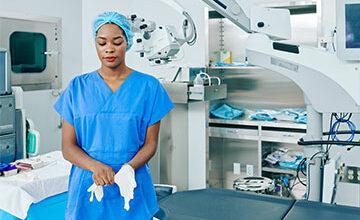
Sonographer Job Description and Roles/Responsibilities, Qualifications
Sonographer job description: A sonographer, creates ultrasound images of various parts of the body using imaging equipment and soundwaves. They are taught how to acquire and analyze sonographic images. These images are used to assist doctors in diagnosing and treating a variety of medical conditions.Information Guide Nigeria
A sonographer uses high-frequency sound waves to create images of the body’s internal organs and tissues to help doctors diagnose and monitor a wide range of conditions and diseases. A sonographer is also known as an ultrasound technician or a diagnostic medical sonographer.
👉 Relocate to Canada Today!
Live, Study and Work in Canada. No Payment is Required! Hurry Now click here to Apply >> Immigrate to CanadaSonographers work with Medical Practitioners to acquire, interpret, and selectively record anatomical images, physical data, and real-time physiological information using ultrasound equipment.Sonographer Job Description
A sonographer assists doctors and other healthcare providers in diagnosing patients’ ailments. They use specialized equipment to record images of internal organs using high-frequency sound waves. This occupation is also known as ultrasound technician, diagnostic medical sonographer, or sonographer.
Sonographers have direct contact with patients and physicians. They may specialize in obstetric and gynecologic sonography, abdominal sonography, breast sonography, vascular sonography, or cardiac sonography.How to Check NYIF Training Portal 2022 Login Platform
Responsibilities of a Sonographer
- Explaining sonographic procedures to patients, answering questions, preparing patients by applying gel to their skin, and positioning patients on the table
- Assuring clear images for diagnostic purposes and adjusting sonographic equipment as needed.How To Write Thank You Messages For Birthday Wishes
- Choosing the appropriate settings and adjusting the positions of the patients accordingly.
- Monitoring and caring for patients during procedures to ensure their safety and comfort.
- Preliminary findings are used to select and examine images, look for differences between healthy and pathological areas, and determine if the scope of the exam should be expanded.
- The sonograms and preliminary findings are presented to the physicians.
- Completing necessary documentation and keeping patients’ histories and medical records.
- Assisting doctors and medical teams during invasive procedures.
- Sonographic equipment maintenance and cleaning
- Performing medical procedures such as oxygen administration, vital sign monitoring, and emergency treatment.
- Referrals for medical imaging are accepted.
- Determines appropriate equipment to use and selects appropriate equipment settings to provide medical practitioners with diagnostic information
- Calculates procedure details such as exposure length and intensity, as well as recording equipment settings.
- Patients explained procedures and their questions about processes are answered.
- Ensures the patient’s safety during procedures
- Prepares patients, screens, and equipment for procedures by positioning them.
- Determines whether images are suitable for diagnostic purposes and chooses images to show medical practitioners
- Procedure findings are communicated to medical practitioners.
- Prepare the examination room and ultrasound equipment for use. Assist radiologists with ultrasound-guided biopsies and vascular ultrasound procedures as needed.
- Using sonographic equipment, identify and record the appropriate anatomy and pathology.
- Maintain sonography equipment properly and report equipment failures.
- Reports should be written based on the scan results and completion.
- Notify appropriate medical personnel of any abnormalities that require immediate attention.
- Make use of your ability to solve problems and make decisions.
- Work independently or with little supervision, as well as part of a team.
- Manage multiple priorities and projects while remaining flexible in a fast-paced work environment.
- Demonstrate a strong work ethic as well as a friendly and cheerful demeanor.
- Maintain the highest levels of confidentiality possible.
- Pursue professional development in order to continuously improve patient care.
- Taking a patient’s medical history and explaining the procedure
- Supporting patients during the imaging and/or testing process by answering questions about the procedure
- Using ultrasound machines to generate high-quality diagnostic images
- Examining test results or images for accuracy and coverage, and capturing additional images as needed
- Differentiating between normal and abnormal findings
- For physicians, analyzing and summarizing diagnostic findings
- Keeping track of findings in patients’ records
- Upkeep of diagnostic imaging equipment, such as ultrasound machines and transducers
Roles of a Sonographer
All sonographer jobs require the use of ultrasound devices to create sonograms, but their interactions with patients, family members, doctors, and nurses vary depending on their specialty.
Sonographers (also known as ultrasound technicians) prepare patients for appointments, perform ultrasounds, review the images they produce, known as sonograms, meet with doctors, and occasionally maintain the machines they use. Reviewing the fundamentals of sonographer education and sonographer jobs will assist you in deciding whether or not to pursue this healthcare specialty.
Sonographer job qualifications/skills
- A sonography associate’s or bachelor’s degree.
- An industry certification and a state license may be beneficial.
- Technical, communication, interpersonal, and patient service skills are required.
- The ability to explain technical terms in a straightforward and understandable manner.
- Excellent vision and attention to detail.
- Excellent analytical, judgment, and decision-making abilities.Npower Recruitment
The most common route to becoming a sonographer is to earn an associate degree from an accredited sonographer training program, with most employers requiring certification after you complete your training. To work as a sonographer in some states, you must obtain a license and complete yearly continuing education courses.JAMB Form
General math and science classes, sonography courses, and hands-on practical training in a healthcare facility are typical sonographer coursework. If you already have training and certification in another healthcare field, you may be able to complete your sonography-specific classes and clinical work in a one-year certificate program.WAEC Result
Some of the soft skills required for success in this career are as follows:
👉 Relocate to Canada Today!
Live, Study and Work in Canada. No Payment is Required! Hurry Now click here to Apply >> Immigrate to Canada- Active listening: Your patients might have concerns about the procedure. To answer their questions, you must first fully comprehend what they are asking.
- Verbal communication: In order to obtain accurate images, you must properly instruct your patients on how to position themselves.
- Interpersonal skills: Aside from listening and speaking abilities, it is also necessary to have excellent social skills as well as the ability to sympathize and empathize with your patients.
- Reading comprehension: Doctors will send you written instructions detailing which images they require.
You must be able to comprehend what they are saying. - Critical thinking: This ability will allow you to weigh alternative solutions to problems.
Sonographer Salary structure
What does a Sonographer earn?
In the United States, the average Sonographer earns $74,600. Sonographers earn the most in San Francisco, with total compensation that is 50% higher than the national average.
Types of Sonographer
They specialize in a variety of fields, including:
- Sonography for Cardiovascular Diagnosis
- Sonography in Neurosonology
- Sonographer for the Abdomen
- Sonography of the Breast
- Sonography in Obstetrics/Gynecology
- Musculoskeletal UltrasoundJAMB Result
Check JAMB Result
Check and Confirm: How much is Dollar to Naira








